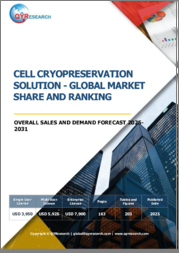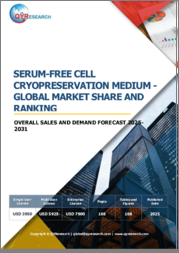
|
시장보고서
상품코드
1676059
세계의 세포 동결보존 시장 조사 보고서 : 산업 분석, 규모, 점유율, 성장, 동향 및 예측(2025-2033년)Global Cell Cryopreservation Market Research Report- Industry Analysis, Size, Share, Growth, Trends and Forecast 2025 to 2033 |
||||||
세계의 세포 동결보존 시장 규모는 2024년 237억 9,000만 달러에서 2033년 1,505억 1,000만 달러에 달하고, 2026-2033년의 예측 기간 동안 22.75%의 견고한 연평균 성장률(CAGR)을 나타낼 것으로 예상됩니다.
세포 동결보존 시장은 세포 기반 치료, 재생의료, 바이오뱅킹 기술 발전에 대한 수요 증가를 배경으로 크게 성장할 것으로 전망됩니다. 세포를 극저온에서 냉각 및 보존하여 생물학적 활동을 정지시키는 과정인 동결보존은 줄기세포, 면역세포, 생식세포 등 다양한 유형의 세포의 생존능력과 기능성을 유지하는 데 필수적입니다. 개인 맞춤형 의료와 혁신적인 치료 접근법이 전 세계적으로 주목받고 있는 가운데, 효과적인 동결보존 기술의 필요성은 점점 더 커지고 있습니다. 이 시장에는 냉동 보존 장비, 냉동 보호제, 보존 솔루션 등 다양한 제품과 서비스가 포함되어 있으며, 모두 생물학적 시료의 무결성을 장기간 보존할 수 있도록 설계되어 있습니다.
기술적 진보가 세포 동결보존 시장을 크게 형성하고 있으며, 동결보존 방법과 장비의 혁신이 공정의 효율성과 신뢰성을 높이고 있습니다. 자동화된 냉동 보존 시스템과 첨단 모니터링 기술의 개발로 온도 제어의 정확도가 향상되어 세포의 생존율을 저해할 수 있는 빙정 형성의 위험이 감소하고 있습니다. 또한, 인공지능과 데이터 분석을 냉동 보존 프로토콜에 통합하여 연구자와 임상의가 보존 조건을 최적화하고 해동 후 세포의 거동을 예측할 수 있도록 돕고 있습니다. 시장이 계속 진화하는 가운데, 연구개발을 우선순위에 두고 냉동보존 솔루션을 강화하는 기업이 늘어나는 수요에서 더 큰 점유율을 차지할 가능성이 높습니다.
또한, 세포 동결보존 시장은 인간 세포 및 조직 사용을 둘러싼 규제 프레임워크와 윤리적 고려사항의 영향을 점점 더 많이 받고 있습니다. 바이오뱅크와 연구기관이 엄격한 규제를 준수하기 위해 노력함에 따라, 표준화되고 검증된 동결보존 프로토콜에 대한 수요는 계속 증가할 것으로 보입니다. 이러한 추세는 세포를 취급하고 보존하는 직원들을 위한 교육 및 인증 프로그램에 대한 투자를 촉진하여 모범 사례 준수를 보장하고 있습니다. 또한, 생명과학 분야에서 지속가능성과 환경적 책임에 대한 관심이 높아짐에 따라 기업들은 친환경적인 동결보존 솔루션을 모색하고 있습니다. 세포 기반 치료 및 재생의료에 대한 관심이 높아지면서 신뢰할 수 있고 효율적인 냉동보존 방법에 대한 필요성이 가장 중요해지고 있으며, 이 역동적인 시장에서 성공하기 위해서는 업계의 요구에 부합하는 제품을 제공하는 기업의 포지셔닝이 중요합니다.
본 보고서는 고객에게 다양한 산업과 시장에 대한 종합적이고 실용적인 통찰력을 제공할 수 있도록 세심하게 작성되었습니다. 각 보고서에는 시장 상황을 완전히 이해하기 위한 몇 가지 중요한 요소가 포함되어 있습니다.
시장 개요: 시장 개요: 정의, 분류, 산업 현황을 포함한 상세한 시장 소개.
시장 성장 촉진요인: 시장 성장에 영향을 미치는 주요 촉진요인, 억제요인, 시장 성장 촉진요인 및 과제를 상세하게 분석합니다. 이 섹션에서는 기술 발전, 규제 변화, 새로운 트렌드 등의 요인을 검토합니다.
세분화 분석 : 제품 유형, 용도, 최종 사용자, 지역 등의 기준에 따라 시장을 명확한 부문으로 분류합니다. 이 분석을 통해 각 부문의 성과와 잠재력을 파악할 수 있습니다.
경쟁상황: 시장 점유율, 제품 포트폴리오, 전략적 이니셔티브, 재무실적 등 주요 시장 진입기업에 대한 종합적인 평가. 주요 기업들이 채택하고 있는 경쟁 역학 및 주요 전략에 대한 고찰이 포함되어 있습니다.
시장 예측 : 과거 데이터와 현재 시장 상황을 바탕으로 일정 기간 동안 시장 규모와 성장 추세를 예측합니다. 여기에는 정량적 분석과 미래 시장 궤적을 나타내는 그래프 표시가 포함됩니다.
지역 분석 : 지역별 시장 성과를 평가하고 주요 시장 및 지역 동향을 파악할 수 있습니다. 지역 시장 역학 및 비즈니스 기회를 이해하는 데 도움이 됩니다.
새로운 트렌드와 기회: 현재 시장 동향과 새로운 시장 동향, 기술 혁신, 잠재적 투자 대상 부문을 식별합니다. 미래 시장 개척 및 성장 전망에 대한 통찰력을 제공합니다.
목차
제1장 서문
제2장 주요 요약
- 시장 하이라이트
- 세계 시장 현황
제3장 세포 동결보존 산업 분석
- 서론 - 시장 역학
- 시장 성장 촉진요인
- 시장 성장 억제요인
- 시장 기회
- 산업 동향
- Porter의 Five Forces 분석
- 시장의 매력 분석
제4장 밸류체인 분석
- 밸류체인 분석
- 원료 분석
- 원료 리스트
- 원료 제조업체 리스트
- 주요 원료 가격 동향
- 잠재적 바이어 리스트
- 마케팅 채널
- 직접 마케팅
- 간접 마케팅
- 마케팅 채널 발전 동향
제5장 세계의 세포 동결보존 시장 분석 : 제품 유형별
- 제품 유형별 개요
- 과거 데이터 및 예측 데이터
- 제품 유형별 분석
- 동결 보호제(Dimethyl Sulfoxide (DMSO), 에틸렌글리콜, 글리세롤, 기타 약제)
- 기기(냉각기, 인큐베이터, 액체 질소 공급 탱크, 동결보존 소모품)
제6장 세계의 세포 동결보존 시장 분석 : 세포 유형별
- 세포 유형별 개요
- 과거 데이터 및 예측 데이터
- 세포 유형별 분석
- 줄기세포
- 난모세포 및 배아세포
- 정자세포
- 간세포
- 기타
제7장 세계의 세포 동결보존 시장 분석 : 용도별
- 용도별 개요
- 과거 데이터 및 예측 데이터
- 용도별 분석
- Drug Discovery & Development
- 재생의료
- 장기 이식
- 임상 연구
- 기타
제8장 세계의 세포 동결보존 시장 분석 : 최종 용도별
- 최종 용도별 개요
- 과거 데이터 및 예측 데이터
- 최종 용도별 분석
- 병원 및 클리닉
- 바이오테크놀러지 및 제약회사
- 연구 및 학술기관
- 임상시험수탁기관(CRO)
제9장 세계의 세포 동결보존 시장 분석 : 지역별
- 지역별 전망
- 서론
- 북미의 판매 분석
- 개요, 분석과 예측
- 북미 : 부문별
- 북미 : 국가별
- 미국
- 캐나다
- 멕시코
- 유럽의 판매 분석
- 개요, 분석과 예측
- 유럽 : 부문별
- 유럽 : 국가별
- 영국
- 프랑스
- 독일
- 이탈리아
- 러시아
- 기타 유럽
- 아시아태평양의 판매 분석
- 개요, 분석과 예측
- 아시아태평양 : 부문별
- 아시아태평양 : 국가별
- 중국
- 인도
- 일본
- 한국
- 호주
- 동남아시아
- 기타 아시아태평양
- 라틴아메리카의 판매 분석
- 개요, 분석과 예측
- 라틴아메리카 : 부문별
- 라틴아메리카 : 국가별
- 브라질
- 아르헨티나
- 페루
- 칠레
- 기타 라틴아메리카
- 중동 및 아프리카의 판매 분석
- 개요, 분석과 예측
- 중동 및 아프리카 : 부문별
- 중동 및 아프리카 : 국가별
- 사우디아라비아
- 아랍에미리트(UAE)
- 이스라엘
- 남아프리카공화국
- 기타 중동 및 아프리카
제10장 세포 동결보존 기업 경쟁 구도
- 세포 동결보존 시장 경쟁
- 제휴, 협엄 및 계약
- 인수합병(M&A)
- 신제품 발매
- 기타 개발
제11장 기업 개요
- 기업 점유율 분석
- 시장 집중도
- Thermo Fisher Scientific Inc.
- Sartorius AG
- PromoCell GmbH
- BioLife Solutions Inc.
- Merck KGaA
- HiMedia Laboratories
- Creative Biolabs
- Corning Incorporated
- GE Healthcare
- Danaher Corporation
Global Cell Cryopreservation Market size is anticipated to grow from USD 23.79 Billion in 2024 to USD 150.51 Billion by 2033, showcasing a robust Compound Annual Growth Rate (CAGR) of 22.75% during the forecast period of 2026 to 2033.
The Cell Cryopreservation market is poised for significant growth, driven by the increasing demand for cell-based therapies, regenerative medicine, and advancements in biobanking technologies. Cryopreservation, the process of cooling and storing cells at very low temperatures to halt biological activity, is essential for preserving the viability and functionality of various cell types, including stem cells, immune cells, and reproductive cells. As the global focus on personalized medicine and innovative therapeutic approaches intensifies, the need for effective cryopreservation techniques is becoming increasingly critical. This market encompasses a wide range of products and services, including cryopreservation equipment, cryoprotectants, and storage solutions, all designed to ensure the integrity of biological samples over extended periods.
Technological advancements are significantly shaping the Cell Cryopreservation market, with innovations in cryopreservation methods and equipment enhancing the efficiency and reliability of the process. The development of automated cryopreservation systems and advanced monitoring technologies is improving the precision of temperature control and reducing the risk of ice crystal formation, which can compromise cell viability. Additionally, the integration of artificial intelligence and data analytics in cryopreservation protocols is enabling researchers and clinicians to optimize storage conditions and predict cell behavior post-thaw. As the market continues to evolve, companies that prioritize research and development to enhance their cryopreservation solutions will likely capture a larger share of the growing demand.
Moreover, the Cell Cryopreservation market is increasingly influenced by regulatory frameworks and ethical considerations surrounding the use of human cells and tissues. As biobanks and research institutions strive to comply with stringent regulations, the demand for standardized and validated cryopreservation protocols will continue to rise. This trend is driving investment in training and certification programs for personnel involved in cell handling and storage, ensuring that best practices are followed. Furthermore, the growing emphasis on sustainability and environmental responsibility in the life sciences sector is prompting companies to explore eco-friendly cryopreservation solutions. As the focus on cell-based therapies and regenerative medicine expands, the need for reliable and efficient cryopreservation methods will be paramount, positioning companies that align their offerings with industry needs for success in this dynamic market.
Our reports are meticulously crafted to provide clients with comprehensive and actionable insights into various industries and markets. Each report encompasses several critical components to ensure a thorough understanding of the market landscape:
Market Overview: A detailed introduction to the market, including definitions, classifications, and an overview of the industry's current state.
Market Dynamics: In-depth analysis of key drivers, restraints, opportunities, and challenges influencing market growth. This section examines factors such as technological advancements, regulatory changes, and emerging trends.
Segmentation Analysis: Breakdown of the market into distinct segments based on criteria like product type, application, end-user, and geography. This analysis highlights the performance and potential of each segment.
Competitive Landscape: Comprehensive assessment of major market players, including their market share, product portfolio, strategic initiatives, and financial performance. This section provides insights into the competitive dynamics and key strategies adopted by leading companies.
Market Forecast: Projections of market size and growth trends over a specified period, based on historical data and current market conditions. This includes quantitative analyses and graphical representations to illustrate future market trajectories.
Regional Analysis: Evaluation of market performance across different geographical regions, identifying key markets and regional trends. This helps in understanding regional market dynamics and opportunities.
Emerging Trends and Opportunities: Identification of current and emerging market trends, technological innovations, and potential areas for investment. This section offers insights into future market developments and growth prospects.
SEGMENTATION COVERED IN THE REPORT
By Type
- Cryopreservation Media Agent (Ethylene Glycol, Dimethyl Sulfoxide, Glycerol, Others)
- Equipment Type (Freezers, Liquid Nitrogen Supply Tanks, Others)
By Application
- Stem Cells
- Oocytes Cells
- Sperm Cells
- Others
By End User
- Pharmaceutical And Biotechnology Company
- Research Institute
- Others
- COMPANIES PROFILED
- PromoCell GmbH
- BioLife Solutions Inc.
- HiMedia Laboratories
- Merck Group KGaA
- Lonza
- Thermo Fisher Scientific Inc.
- Eppendorf Corporate
- Sartorius AG
- Creative Biolabs
- Danaher Corporation
- The above list can be customized.
TABLE OF CONTENTS
1 . PREFACE
- 1.1. Report Description
- 1.1.1. Objective
- 1.1.2. Target Audience
- 1.1.3. Unique Selling Proposition (USP) & offerings
- 1.2. Research Scope
- 1.3. Research Methodology
- 1.3.1. Market Research Process
- 1.3.2. Market Research Methodology
2 . EXECUTIVE SUMMARY
- 2.1. Highlights of Market
- 2.2. Global Market Snapshot
3 . CELL CRYOPRESERVATION INDUSTRY ANALYSIS
- 3.1. Introduction - Market Dynamics
- 3.2. Market Drivers
- 3.3. Market Restraints
- 3.4. Opportunities
- 3.5. Industry Trends
- 3.6. Porters Five Force Analysis
- 3.7. Market Attractiveness Analysis
- 3.7.1 Market Attractiveness Analysis By Product Type
- 3.7.2 Market Attractiveness Analysis By Cell Type
- 3.7.3 Market Attractiveness Analysis By Application
- 3.7.4 Market Attractiveness Analysis By End-use
- 3.7.5 Market Attractiveness Analysis By Region
4 . VALUE CHAIN ANALYSIS
- 4.1. Value Chain Analysis
- 4.2. Raw Material Analysis
- 4.2.1. List of Raw Materials
- 4.2.2. Raw Material Manufactures List
- 4.2.3. Price Trend of Key Raw Materials
- 4.3. List of Potential Buyers
- 4.4. Marketing Channel
- 4.4.1. Direct Marketing
- 4.4.2. Indirect Marketing
- 4.4.3. Marketing Channel Development Trend
5 . GLOBAL CELL CRYOPRESERVATION MARKET ANALYSIS BY PRODUCT TYPE
- 5.1 Overview by Product Type
- 5.2 Historical and Forecast Data
- 5.3 Analysis by Product Type
- 5.4 Cryoprotectant Agents (Dimethyl Sulfoxide (DMSO), Ethylene Glycol, Glycerol, Other Agents) Historic and Forecast Sales by Regions
- 5.5 Equipment (Freezers, Incubators, Liquid Nitrogen Supply Tanks, Cryopreservation Consumables) Historic and Forecast Sales by Regions
6 . GLOBAL CELL CRYOPRESERVATION MARKET ANALYSIS BY CELL TYPE
- 6.1 Overview by Cell Type
- 6.2 Historical and Forecast Data
- 6.3 Analysis by Cell Type
- 6.4 Stem Cells Historic and Forecast Sales by Regions
- 6.5 Oocytes And Embryotic Cells Historic and Forecast Sales by Regions
- 6.6 Sperm Cells Historic and Forecast Sales by Regions
- 6.7 Hepatocytes Historic and Forecast Sales by Regions
- 6.8 Other Historic and Forecast Sales by Regions
7 . GLOBAL CELL CRYOPRESERVATION MARKET ANALYSIS BY APPLICATION
- 7.1 Overview by Application
- 7.2 Historical and Forecast Data
- 7.3 Analysis by Application
- 7.4 Drug Discovery And Development Historic and Forecast Sales by Regions
- 7.5 Regenerative Medicine Historic and Forecast Sales by Regions
- 7.6 Organ Transplantation Historic and Forecast Sales by Regions
- 7.7 Clinical Research Historic and Forecast Sales by Regions
- 7.8 Other Historic and Forecast Sales by Regions
8 . GLOBAL CELL CRYOPRESERVATION MARKET ANALYSIS BY END-USE
- 8.1 Overview by End-use
- 8.2 Historical and Forecast Data
- 8.3 Analysis by End-use
- 8.4 Hospitals And Clinics Historic and Forecast Sales by Regions
- 8.5 Biotechnology And Pharmaceutical Companies Historic and Forecast Sales by Regions
- 8.6 Research And Academic Institutes Historic and Forecast Sales by Regions
- 8.7 Contract Research Organizations (CROs) Historic and Forecast Sales by Regions
9 . GLOBAL CELL CRYOPRESERVATION MARKET ANALYSIS BY GEOGRAPHY
- 9.1. Regional Outlook
- 9.2. Introduction
- 9.3. North America Sales Analysis
- 9.3.1. Overview, Historic and Forecast Data Sales Analysis
- 9.3.2. North America By Segment Sales Analysis
- 9.3.3. North America By Country Sales Analysis
- 9.3.4. United State Sales Analysis
- 9.3.5. Canada Sales Analysis
- 9.3.6. Mexico Sales Analysis
- 9.4. Europe Sales Analysis
- 9.4.1. Overview, Historic and Forecast Data Sales Analysis
- 9.4.2. Europe by Segment Sales Analysis
- 9.4.3. Europe by Country Sales Analysis
- 9.4.4. United Kingdom Sales Analysis
- 9.4.5. France Sales Analysis
- 9.4.6. Germany Sales Analysis
- 9.4.7. Italy Sales Analysis
- 9.4.8. Russia Sales Analysis
- 9.4.9. Rest Of Europe Sales Analysis
- 9.5. Asia Pacific Sales Analysis
- 9.5.1. Overview, Historic and Forecast Data Sales Analysis
- 9.5.2. Asia Pacific by Segment Sales Analysis
- 9.5.3. Asia Pacific by Country Sales Analysis
- 9.5.4. China Sales Analysis
- 9.5.5. India Sales Analysis
- 9.5.6. Japan Sales Analysis
- 9.5.7. South Korea Sales Analysis
- 9.5.8. Australia Sales Analysis
- 9.5.9. South East Asia Sales Analysis
- 9.5.10. Rest Of Asia Pacific Sales Analysis
- 9.6. Latin America Sales Analysis
- 9.6.1. Overview, Historic and Forecast Data Sales Analysis
- 9.6.2. Latin America by Segment Sales Analysis
- 9.6.3. Latin America by Country Sales Analysis
- 9.6.4. Brazil Sales Analysis
- 9.6.5. Argentina Sales Analysis
- 9.6.6. Peru Sales Analysis
- 9.6.7. Chile Sales Analysis
- 9.6.8. Rest of Latin America Sales Analysis
- 9.7. Middle East & Africa Sales Analysis
- 9.7.1. Overview, Historic and Forecast Data Sales Analysis
- 9.7.2. Middle East & Africa by Segment Sales Analysis
- 9.7.3. Middle East & Africa by Country Sales Analysis
- 9.7.4. Saudi Arabia Sales Analysis
- 9.7.5. UAE Sales Analysis
- 9.7.6. Israel Sales Analysis
- 9.7.7. South Africa Sales Analysis
- 9.7.8. Rest Of Middle East And Africa Sales Analysis
10 . COMPETITIVE LANDSCAPE OF THE CELL CRYOPRESERVATION COMPANIES
- 10.1. Cell Cryopreservation Market Competition
- 10.2. Partnership/Collaboration/Agreement
- 10.3. Merger And Acquisitions
- 10.4. New Product Launch
- 10.5. Other Developments
11 . COMPANY PROFILES OF CELL CRYOPRESERVATION INDUSTRY
- 11.1. Company Share Analysis
- 11.2. Market Concentration Rate
- 11.3. Thermo Fisher Scientific Inc.
- 11.3.1. Company Overview
- 11.3.2. Company Revenue
- 11.3.3. Products
- 11.3.4. Recent Developments
- 11.4. Sartorius AG
- 11.4.1. Company Overview
- 11.4.2. Company Revenue
- 11.4.3. Products
- 11.4.4. Recent Developments
- 11.5. PromoCell GmbH
- 11.5.1. Company Overview
- 11.5.2. Company Revenue
- 11.5.3. Products
- 11.5.4. Recent Developments
- 11.6. BioLife Solutions Inc.
- 11.6.1. Company Overview
- 11.6.2. Company Revenue
- 11.6.3. Products
- 11.6.4. Recent Developments
- 11.7. Merck KGaA
- 11.7.1. Company Overview
- 11.7.2. Company Revenue
- 11.7.3. Products
- 11.7.4. Recent Developments
- 11.8. HiMedia Laboratories
- 11.8.1. Company Overview
- 11.8.2. Company Revenue
- 11.8.3. Products
- 11.8.4. Recent Developments
- 11.9. Creative Biolabs
- 11.9.1. Company Overview
- 11.9.2. Company Revenue
- 11.9.3. Products
- 11.9.4. Recent Developments
- 11.10. Corning Incorporated
- 11.10.1. Company Overview
- 11.10.2. Company Revenue
- 11.10.3. Products
- 11.10.4. Recent Developments
- 11.11. GE Healthcare
- 11.11.1. Company Overview
- 11.11.2. Company Revenue
- 11.11.3. Products
- 11.11.4. Recent Developments
- 11.12. Danaher Corporation
- 11.12.1. Company Overview
- 11.12.2. Company Revenue
- 11.12.3. Products
- 11.12.4. Recent Developments



















